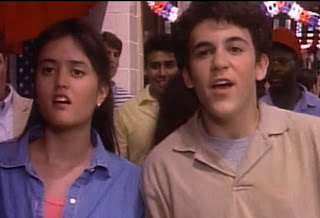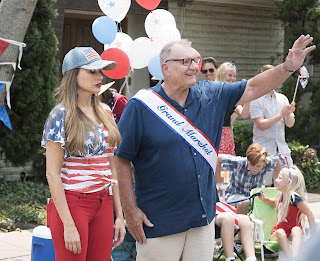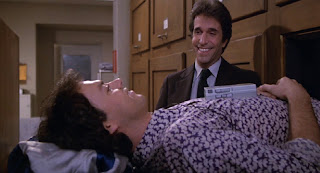By Michael Lyons
The 1980s was a true "Golden Age" for summer movies. The Jaws and Star Wars summers of the '70s gave way to a decade during which Hollywood realized that the warm weather months could be the bread and butter that made studio accountants extremely happy.
And, as the '80s started, these same studios held their most significant films, by some of their most talented directors, starring some of the screen's biggest names, for summer.
The result was some of the biggest films of all time, now all drenched in the soft glow of nostalgic popularity, most of which came out during the summer and many of which came out during the summer of 1982.
There were so many defining summers for summer movies during this decade, and deference must be paid to the summer movie season of 1982.
From May through August that year, audiences could go to see not one but two sequels to two of the most famous film franchises of all time; the first feature to extensively use computer animation; several landmark science fiction films; Don Bluth's first animated feature; Arnold Schwarzenegger's first starring role; Ron Howard's first major studio film as a director; and not one, but two Steven Spielberg films, with one going on to become the most popular and one of the most beloved films of all time.
It all happened forty years ago this summer. And the movie season was kicked-off with two stars who would become the biggest names in action over the next decade.
May
The month of May saw summer (or at least the summer movie season) start early on May 14th, with the release of Conan the Barbarian. An eagerly anticipated adaptation of the stories by Robert E. Howard, the film would mark the first feature role for Arnold Schwarzenegger and signal the start of a career that would make him an action star. Many consider it his best and defining role, and Conan the film, released smack-dab in the '80s sword-and-sorcery movie fad, is still one of the best of that short-lived genre.

Memorial Day Weekend of 1982 saw the return of one of the film's most iconic characters with Rocky III. Sylvester Stallone returned in the role that made him a star, and also as wrote and directed this third outing. With an opponent named Clubber Lang, played with ferocity by Mr. T, who would become one of the decade's most emblematic figures. Rocky III is a smartly crafted continuation of the Balboa saga, with a commentary on fame and an inspirational message about how it's never too late for a comeback that still resonates four decades later.
Want more from 1982's May at the movies? How about the big-screen adaptation of Annie (directed by John Huston!) and Steve Martin in Carl Reiner's underrated, creative comedy Dead Men Don't Wear Plaid, which featured the comedian "spliced into" classic Hollywood film noir.
This was followed by a month that truly made 1982 a "Spielberg Summer."
June
This month started with Star Trek II: The Wrath of Kahn, a sequel that many feel saved the franchise. While Star Trek: The Motion Picture was a hit, many were disappointed in it. Still, there was enough there to warrant a second launch of the Enterprise.
Wrath of Kahn brought back the camaraderie that so many loved from the series, adding a healthy dose of humor, Ricardo Montalban as a fantastic villain (and a great connection to the TV show), and an emotional message ("The needs of the many outweigh the needs of the few").
With Wrath of Kahn, Star Trek really did feel like a motion picture!
Opening the same day was a movie that would forever change our perception of the "haunted house" plot paradigm. Poltergeist, as the poster read, definitely knew what "scared us," telling the story of a family (parents Craig T. Nelson and Jobeth Williams are so perfectly believable) who find their new California suburban home haunted by the titular beings, vengeful ghosts caught between our world and the next.
Produced by Steven Spielberg and directed by Tobe Hooper (which is still a legendary Hollywood "behind-the-scenes" story), Poltergeist was upfront in its scares, combining the realism of William Friedkin's Exorcist with an otherworldly flair that became a Spielberg staple.
The result was a movie that continues to jolt audiences and inspires filmmakers (most notably James Wan, who has taken this to the next level), with iconic scenes as soon as one mentions them (clown doll hiding under your bed?). Poltergeist also gave us the chilling line that entered the lexicon, "They're here!"
This could have also referred to a new generation of summer movies and blockbusters that would continue to make film history, particularly one week after Poltergeist when another Spielberg film debuted.
E. T. The Extra-Terrestrial opened on June 11, 1982, to gushing critical praise and lines at movie box offices that hadn't been seen since the summer of Star Wars in 1977. The story of a "boy and his alien," young Elliot and the otherworldly E.T., who wants to go "home," was a once-in-a-generation movie.
And, if you were lucky enough to see it in theaters during the summer of '82, you knew it.
Not since the days of Disney's classics like Pinocchio, or MGM's Wizard of Oz, had a movie so connected with our emotions, and not since George Lucas' Star Wars, Spielberg's Jaws, or the pair's Raiders of the Lost Ark, from recent summers, had such excitement been felt at a movie.
This writer still has a memory that rings in his mind of the rainy day, packed house at the Smithtown Movie Theater, bursting into applause as E.T.'s spaceship streaks a rainbow across the sky at the end of the film.
The impact of E.T. The Extra-Terrestrial can, obviously, in no way, be understated these four decades later. This rare film soared beyond the screen and has secured a place in our hearts and minds that we save for those elusive "bests of all time."
As critic Roger Ebert wrote: "E.T. The Extra-Terrestrial is a reminder of what movies are for. Most movies are not for any one thing, of course. Some are to make us think, some to make us feel, some to take us away from our problems, and some to help us examine them. What is enchanting about E.T. is that, in some measure, it does all of those things."
Not long after E.T. hit theaters, another influential film debuted. At the time, the film underperformed but is today considered a groundbreaking science fiction feat, and that was Blade Runner. Director Ridley Scott quickly established his "style" with this rain-drenched, Tokyo-inspired, neon-infused vision of the future.
A slowly-paced film starring one of the summer movie stars of the decade, Harrison Ford, Blade Runner would introduce us to terms like "neo-noir" and "cyberpunk" and become a fantastic cult favorite that creative generations are still examining.
Equally influential was director John Carpenter's re-imagining of The Thing. A remake of the 1951 black-and-white B movie, The Thing from Another World (which was very influential for Carpenter), the film told the gruesome tale of a helicopter pilot (Kurt Russell) and a team of researchers in Antarctica who are overtaken by a parasitic lifeform.
The Thing featured gut-churning but incredibly compelling effects by Rob Bottin, astonishing in their pre-CGI-practicality. Initially, a box-office failure, The Thing is now considered a gold standard of sci-fi and horror.
And so, the summer movie season of 1982 headed into July, where a groundbreaking film pointed toward the future of movies.
July
In the summer of 1982, a young animator named John Lasseter sat in a movie theater in wide-eyed wonder, knowing that he had seen his future path in animation. The someday Pixar founding member and creator of such landmarks as Toy Story was watching Tron.
In July of 1982, the film certainly did lay the early groundwork for what was to come in the movie industry. Telling the story of human computer programmers who find themselves inside a video game, Tron didn't wow critics and audiences with its story. Still, its extensive use of computer animation was a true harbinger of all that was to come.
Although not initially successful, it was a landmark film in that it was an early glimpse into the movie world we live in today, as CGI is now such a mainstay of every production.
Another animator, Don Bluth, had a seminal moment in July of 1982. The animator who led a walk-out from Disney, wanting to chart a new course for animation, got that chance with The Secret of NIMH.
A dark tale of laboratory mice, NIMH brought a definite Disney look but different sensibilities, signaling Bluth as a significant player in animation, which would continue through the decade.
July of '82 was also prime time for some comedies that deserve a revisit while forgotten through the years. These include the Broadway musical adaptation, The Best Little Whorehouse in Texas, starring Burt Reynolds and Dolly Parton, and director Garry Marshall's Airplane-like send-up of soap operas, Young Doctors in Love.
Then, there was Night Shift, Ron Howard's first major studio film as a director, which probably ranks as one of the most underrated comedies of the decade. Two third shift employees of a New York City morgue - a mild-mannered introvert (Henry Winkler) and a loud-mouth ner do well (Michael Keaton) - find themselves working as pimps operating out of that morgue.
Night Shift is more than just this off-beat, funny concept; it's an all-around funny film with terrific characters, moments, development, and a scene-stealing, star-making turn from Keaton.
This month also saw an eagerly awaited adaptation with The World According to Garp. From the best-selling John Irving novel, the film starred Robin Williams (in his first role that allowed him to display his acting and comedic skills) as a writer who leads quite the eccentric and, at times, tragic life.
As the summer of 1982 headed into the August finale, the summer movie season still had a few hits up its sleeve.
August
Just in time for back-to-school came Fast Times at Ridgemont High. Chronicling a year for students at the titular high school, director Amy Heckerling's comedy (from a script by Cameron Crowe) is also a poignant, coming-of-age story that introduced the world to the talents of Sean Penn, as lovable stoner surfer Jeff Spicoli and allowed a generation to fall in love with actress Phoebe Cates.
This summer, there was room for drama with the now-iconic, An Officer and a Gentleman. Richard Gere plays Zach Mayo, who struggles through training as a US Navy Aviation Officer, conflicting with a tough Sergeant, played by Louis Gossett, Jr., in an Oscar-winning role.
An Officer and a Gentleman was a late-summer box office success, with the film's hit Academy Award-winning song "Up Where We Belong" heard on radios for the rest of the year, and the film provided this summer with a romantic, happy ending.
Reflecting on the Summer Movie Season of 1982
It was quite the four months, filled with movies that still echo in the halls of motion picture history, pop culture fanaticism, and nostalgic warmth.
Sure, there would be plenty of super movie summers ahead, such as the '84 summer of Ghostbusters and the Batman summer of '89. And the parade of mammoth warm weather movies would continue well into the '90s with behemoths like Jurassic Park and The Lion King.
But, forty years ago this summer, moviegoers were in the midst of an amazing "Golden Age" that still shines just as bright today.
Sources:
rogerebert.com
My book Drawn to Greatness is now available on Amazon!
For more of my articles and to listen to my podcasts head over to Words From Lyons






















